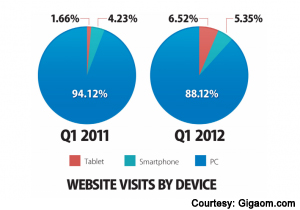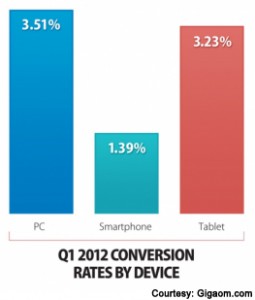As I discussed in my last article on the blog, Making Marketing Mobile, companies have to ensure that their integrated marketing plans include concentration on the digital space. More specifically, this focus will need to be targeted to mobile device channels to ensure that marketing messages are reaching customers where they work and play. As more and more consumers use their tablet devices to access the Internet, any integrated marketing plan must include tablet-based tactics as a primary medium.
The iPad, Android-based tablets, and even the upcoming Microsoft Surface are all likely to continue to chip away purchase and usage shares from the traditional PC or iOS-based desktop markets. Mobility, dynamic apps and ease-of-use are all attractive advantages that tablets have over desktops. Consumers are modifying their purchasing behavior as the technology becomes more affordable and marketers continue to fully embrace this hardware channel.
 Monetate, an online marketing technology company that provides analysis to many of the top e-commerce sites, analyzed close to 100 million online shopping sessions for the first quarter of 2012. Their analysis showed that PC traffic to e-commerce sites significantly dropped by four percent. Monetate predicts that the PC market share will dip below 75 percent over the next 12 months.
Monetate, an online marketing technology company that provides analysis to many of the top e-commerce sites, analyzed close to 100 million online shopping sessions for the first quarter of 2012. Their analysis showed that PC traffic to e-commerce sites significantly dropped by four percent. Monetate predicts that the PC market share will dip below 75 percent over the next 12 months.
Tablets are even becoming a more direct competitor to smartphones. The Monetate study showed that tablets are now trending ahead of smartphones in delivering the greatest amounts of traffic to e-commerce sites. During the first quarter of 2012, tablet traffic outpaced smartphone traffic for the first time by almost one and a quarter percent. Of the tablet-based traffic, almost all of that traffic (95 percent), originated from an iPad.
Kurt Heinemann, who serves as Monetate’s CMO, says these traffic pattern changes are  likely due to the fact that tablets “offer the best of both worlds, the portability of a smartphone but with a bigger UI that encourages shopping and browsing.” Heinmann adds that he believes that tablets are on track to become one of the primary gateways onto the Internet for all online users. The influence of a better user interface with tablets is becoming apparent with conversion rates once users land on an e-commerce site. The Monetate report indicated that converted purchases on tablets are just a fraction of a percentage point behind those originating from PCs, and that tablet conversions should overtake those from PCs by 2014.
likely due to the fact that tablets “offer the best of both worlds, the portability of a smartphone but with a bigger UI that encourages shopping and browsing.” Heinmann adds that he believes that tablets are on track to become one of the primary gateways onto the Internet for all online users. The influence of a better user interface with tablets is becoming apparent with conversion rates once users land on an e-commerce site. The Monetate report indicated that converted purchases on tablets are just a fraction of a percentage point behind those originating from PCs, and that tablet conversions should overtake those from PCs by 2014.
Online marketers are now beginning to understand that the tablet environment is vital to the continuing success of their overall e-commerce efforts. Instead of a wide-brush approach, marketing teams for brands, products and services must more effectively focus on optimizing both the visual and transactional experiences for consumers. The question is just how this process should be accomplished.
Many e-commerce sites are mobile-optimized. That is, the sites are built to have a mobile component that is served to devices when the browser makes a server request from a mobile or tablet device. While there are still limitations that exist with mobile and tablet browsers, improvements are being made continuously to make a user’s experience as much like that of a PC as possible. There are now new Web browsers available from Firefox and Google Chrome that have been engineered specifically for both the iOS and Android operating systems that provide a more “full browser” experience. Microsoft’s Surface tablet browser will be built on the Internet Explorer foundation. Online marketing teams will need to work closely with their interactive development and design teams to continually improve and optimize all content to work more seamlessly in these new browser environments.
How do tablet apps fit into this equation? That is a question that many companies are currently addressing. Does a company simply rely on a tablet user to access an e-commerce site through the native or add-on browser? Or do they invest the time and money to develop apps that are tailored to the tablet environment?
As we have seen, iPad apps from the App Store and Android apps from Google Play have vastly improved the user experience, as well as allowing marketers to take advantage of the hardware experience to create more dynamic and functional interactions. Many companies have been very aggressive in the development of multi-platform apps that can engage a consumer and help encourage actual purchase conversions.
Other companies could be considered “stragglers” in that they have not made the time or resources commitment to develop robust applications to improve their own e-commerce processes. These types of companies are now playing catch-up to their competitors, and missing out on opportunities to build and grow their presence and influence in tablet experiences. According to a Nielsen survey in early 2012, the amount of time Internet users spend with mobile iOS and Android apps is by far outweighing browser activity. The top 50 apps consumed 58% of all U.S. total app time usage. Further analysis of the Nielsen study indicates that these trends will continue and the gap between apps and browsers will continue to widen.
From all the data examined, it appears that it would be an essential function of any integrated marketing plan to include a concentration on the tablet environment. The studies indicate the trends towards tablet use as a primary online access tool will continue. If your company is not up for the challenge, it would be advisable for your marketing teams to take a very hard look at the direction that your overall marketing missions is taking. Otherwise, you will find yourself on the wrong side of successful online marketing in a highly-competitive environment.


One Response to Tablets Take a Shopping Trip